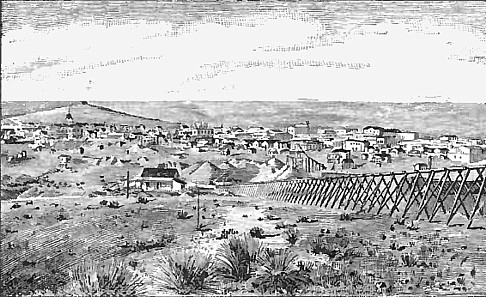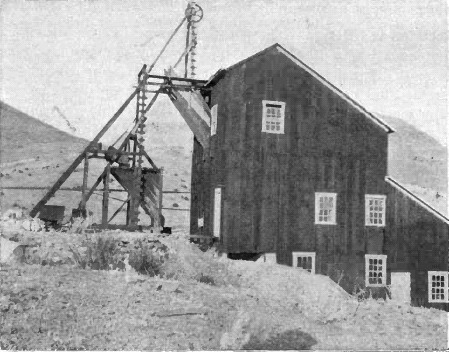In the sudden occurrence of remarkable events which followed the war between the United States and Mexico, the settlement of the great American basin was included. Ceded to the United States all at the same time, together with California, was this region of the Spanish domain without outpost or settlement east of the Sierra Nevada, with no distinctive name, being described only by local names, and divided into valleys.
Much notoriety has been given to Fremont s explorations of Nevada, and less to a far greater movement that of the Latter-day Saints, who founded a city two thirds of the way across the continent, and in so doing forestalled the necessity about to arise for such a station in the wilderness to secure and hold such a place. In the month of March following the treaty with Mexico, the inhabitants of Salt Lake valley met and organized the state of Deseret, the boundaries of which included the whole of the recently acquired Mexican territory outside of California. Not long after Deseret was founded, the Mormons sent settlers east, and H. S. Beatie took possession of the site of the present town site of Genoa, and thereupon erected a log house, the first permanent American home in the state. The California gold rush attracted considerable immigrants passing through Nevada, and a few thought to try their hand prospecting in Nevada while on their way west. In July of 1849, while on his way to the California gold mines, Abner Blackburn prospected one of the lateral ravines of the Carson River valley, and discovered placers, including a gold nugget weighing half an ounce, but the gold was not found in quantities sufficient deter those seeking the riches of California. Still, word of his find spread, and some immigrants stopped to mine for a while in Gold Canyon while on their way to California. The gold this deposit produced was rich in silver, technically electrum, and was worth no more than fourteen dollars to the ounce. Yet as the diggings yielded a fair day’s wages, there were a few hundred men who would work here during the mining season (when there was water), and some of them established settlements upon land claims near by. After a number of years of regular work, the placers began to play out and the local miners began to search the area for other possibilities.
Below is a collection of 70 true tales of adventure and history from Nevada's early gold mining days:
1. The Early Days In The
Nevada Territory
2. Discovery of the Comstock Lode At Gold Hill
3. Discovery of the Comstock Lode At Virginia City
4. The Comstock Lode Is A Silver Mine
5. Reminiscences Of The Early Comstock Mining Days
6. Early Workings in The Ophir Mine at Virginia City
7. How the Comstock Discoverers Fared
8. The Nevada Comstock Silver Rush
9. War With The Piute Indians
10. Milling the Rich Comstock Silver Ores
11. The Loss Of Mercury into the Carson River
12. Investing In The Comstock Gold and Silver Mines
13. How The Comstock Mines Were Worked
14. Strange Phenomena In Old Virginia City
15. Deadly Fire in the Comstock Gold and Silver Mines
16. Death In The Mines
17. The History Of Virginia City and Gold Hill
18. The Virginia and Truckee Railroad
19. The 601 Vigilance Committee – Law and Justice
20. The Mines of the Comstock Lode
21. Working Deep Underground In the Comstock Mines
22. Extracting The Gold and Silver From The Ores
23. Mining Stock Speculations: Fortunes Made and Lost
24. The Terrible Story Of The Donner Party
25. Stock Pranks and Mischief in the Mines
26. Underground Battles In The Comstock Mines
27. The Silver Wealth Of Mexico And The World
28. The Silver Wealth Of The Comstock Lode
29. Discovery of the Great Bonanza Silver and Gold Mines
30. Con. Virginia and California: The Richest Spot On Earth
31. About The Comstock Bonanza
32. Prospecting Around The Rumor Mill
33. The Great Virginia City Fire of 1875
34. Comstock mining Stock Crash
35. Adolph Sutro Completes His Comstock Tunnel
36. Virginia City Mining Stock Speculations
37. John Mackey,
Silver Miner From Virginia City
38. James Fair, Silver Miner and Partner to Mackey
39. Sandy Bowers and His Mansion
40. Mark Twain and his Practical Jokes
41. The Great White Pine Silver Rush
42. Discovery of The Bonanza Ores At Goldfield:
43. Early Day Mining Reports From Goldfield
44. Early Newspaper Reports Of Goldfield
45. Diamondfield Area Near Goldfield
46. The Rush To Bullfrog
47. The Rush To Gold Crater
48. The Great Tonopah Gold and Silver District
49. Elko County Mines
50. Eureka County Mines –
51. Geology of the
Eureka Mines
52. Other Mining Districts
Within Eureka County
53. The First Ore
Smelter In Nevada
54. Esmerelda County Mining
55. Candelaria and other Esmerelda County
Mining Camps
56. Goldfield
57. Humboldt County Mines
58. Early Days In Humboldt County
59. History Of Rochester, Nevada
60. Lander County Mines
61. The Lost Gold Mine of Charles Breyfogle, Prospector
62. Lincoln County Mines
63. Nye County
64. Carson City (Ormsby) County
65. White Pine County
66. Austin and the Reese River Silver District
67. Discovery of the Rich Silver Lodes of Austin
68. The Dun Glen and Chafey Gold Mines
69. The Geology of Goldfield, Nevada
70. The
Geology of Tonopah, Nevada
Some gold was found in the upper reaches of Six Mile Canyon, and early in June of 1859, two local miners, Peter O Riley and Patrick McLaughlin, being short of water, excavated a small reservoir a short distance above their claims, in which to collect it from a rivulet for the use of their rockers. The material at this spot yielded good values – better than any they had found before – so they kept digging. On the 10th, at a depth of four feet, they came to a stratum of strange looking blue-black colored earth, the nature of which they did not understand. Still, they were pleased with their results, seeing that this deposit was yielding $300 a day to the rocker – a princely sum for the poor miners and far beyond the minimal wages they were used to. Only for about a week did the claim continue to pay in the rich decomposed ore, of which the miners were ignorantly throwing away the black argentite silver sulfide which was the greater part of the ore’s value. The material kept getting harder and less weathered as they dug downward, and on June llth the miners struck a solid ledge four feet in width, the beginning of the famous Comstock Lode. It would still be a matter of weeks until someone assayed the black muck they were throwing out and showed it to be rich silver ore, but the great lode had been found and it was making men rich.
Separated from California by the snowy chain of the Sierra Range, the State of Nevada has been celebrated, since 1860, for its silver mining. In November, 1859, the news of the discovery of some very rich silver mines near Lake Washoe was confirmed at San Francisco; and in June, 1860, the mines of Washoe, the central western portion of the State, had already shipped such rich results to Europe, that the French Ministers of Finance and Commerce dispatched a mining engineer to Nevada to make a close inspection of these wonderful mines. It seemed as if the world were about to be inundated with silver, just as it had been by California gold ten years previously; and what would those economists now say, who had only recently counseled that the value of gold coin should be lowered or that gold should be demonetized on account of the disturbed relation of these precious metals—the bases of the standard of payment throughout the world generally. Whilst the French engineer visited Nevada and prepared his report, the miners of Washoe continued working their veins of metal. Even as late as 1881, the mines on the eastern slope of the Sierra Nevada were annually producing about $12,500,000 of silver, chiefly from the Comstock lode; the total yield of gold from the quartz mines of California is about $17,000,000 per annum. The Comstock lode, in the State of Nevada, may be ranked among the most productive metalliferous deposits ever encountered in the history of mining enterprise; its productive capacity, as now being developed, surpassing, if the mass of its ores do not in richness equal, those of the most famous mines of Mexico and Peru. Virginia City was like no other mining camp in the world. Great men became famous here. They had a Mackay, a Fair, a Flood and an O'Brien. Here once was also the home of Mark Twain, of Dan DeQuill, of Goodwin, of Dagget and numerous others who have shown in greatness.
The known limits of this lode cover a space of 22,546 feet in a nearly due north and south direction (magnetic). The variation of the needle in that locality is 16.4 degrees east. Upon this extensive seat of metalliferous deposits, the mines are divided into three groups: the Virginia Group, seventeen mines, with claims of 13,549 feet; Gold Hill Group, nine mines, of 6,397 feet; American Flat Group, three mines, of 2,600 feet. The three groups of twenty-nine mines thus occupy a total length on the lode of 22,546 feet. The Comstock lode was discovered in 1859, by a well sunk for a water hole on the ground of the Ophir mine; milling the ore began in October of the same year, but the amount of bullion taken out in 1860 is estimated at but $100,000. Since then the Comstock has become the greatest gold and silver mine in the world. To the end of 1878 the yield was estimated at $291,162,205, as follows: From 1860 to 1870 inclusive, of gold and silver together, unclassified, $102,466,240; 1871 to 1878 inclusive, gold, $88,691,498, silver, $91,278,623 ; 1877 and 1878, gold and silver, unclassified, $1,725,844. Making allowance for the loss by slimes and tailings, the gross contents of the lode as worked up to 1878 are estimated at $363,961,205. About 6,500,000 tons of ore have been extracted in this time, which a good authority estimates of an average value to the company of $45 per ton of 2,000 pounds. The great lode has been worked off and on ever since.
While the Comstock may have been the first of the great mineral finds in the state of Nevada, it was by no means the last. Fantastic rich discoveries at Aurora, Eureka, Austin and White Pine continued the major production in the mid 1800s. Nevada continued to grab headlines, fuel the dreams of prospectors and cause gold rush stampedes well into the 20th century with amazing finds at Tonopah, Goldfield, Rochester, National and other locations. Even now, 150 years since the great Comstock discovery, the state sill attracts mining companies and their operations produce far more gold than any other state in the US. Nevada has become not only the state with the greatest silver production, but it has eclipsed California in gold production as well.


